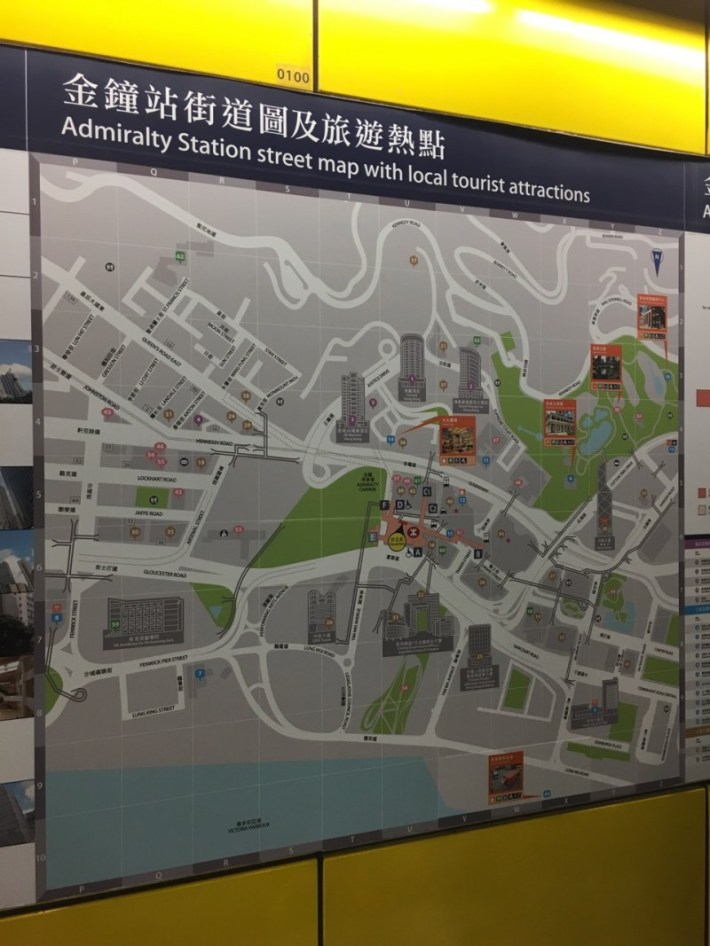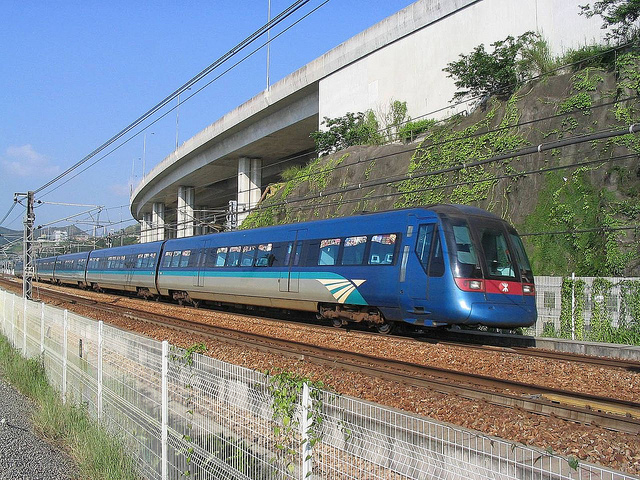Mayor Rahm Emanuel has noted that Hong Kong is a world class city with an express train to its airport, and O'Hare should have one like it to attract more business travelers to Chicago. There's a good backstory about how Hong Kong got an airport express, but it doesn't support Emanuel's push for one.
I spent last weekend in Hong Kong and rode the express train roundtrip, and I experienced first hand what a premium airport train looks and feels like. I also learned how it was funded. The Hong Kong Airport Express is unique in that it's the only train to the airport and it was privately funded by real estate revenues. Emanuel has repeatedly said the goal of the O'Hare Express project "is to ensure that no taxpayer money is used."
The Hong Kong airport train is a high-speed and premium rail service between three downtown stations and the Hong Kong International Airport that debuted in July 1998, when the airport opened. The most expensive one-way journey is $13, but you can save money by purchasing a roundtrip ticket, or paying for your ride along with a multi-day pass. I paid $39 for a roundtrip ticket and three days of unlimited rides on the subway. You can get from downtown to the airport in less than 25 minutes. By comparison, the city of Chicago has said an O'Hare Express ride would probably cost about $30.
MTR built and operates the express train. It's a publicly-traded corporation and the Hong Kong government is the majority shareholder. This is the most significant difference between Hong Kong and any potential scenario in Chicago. Despite Emanuel's assurances it seems unlikely that building a new train line to O'Hare would be profitable, so the project would probably have to involve public funds.

The Hong Kong Airport Express was funded solely by MTR, which earns most of its revenues by developing and leasing buildings above and adjacent to its stations for offices, residential towers, and malls -- lots and lots of malls. MTR also builds and operates the city's subways, and it's one of the only transit agencies in the world that makes a profit. Imagine if the CTA was able to run trains more frequently to nicer stations because it earned money from developing the land along the Orange Line that's currently occupied by parking lots.
The Hong Kong Airport Express remains the only train to the local airport, so there's no competition for a comfortable train ride into the city center. Other transportation options include taxis, and a well-developed bus network.
On the other hand, O'Hare is already served by the Blue Line, which has 24 hour service to downtown and many neighborhoods. Local bus service is only available at the Rosemont station one stop away on the Blue Line, and since departing O'Hare on the Blue Line costs $5 instead of the normal $2.25, it costs a minimum of $5.25 to use a Pace or CTA bus from O'Hare.
Even though the Hong Kong Airport Express the only train service to its airport, less than a quarter of Hong Kong airport passengers use it. However, the airport express won't necessarily have any funding problems due to low ridership because MTR subsidizes all its lines with its real estate operation. In contrast, low ridership on the express train to Toronto's Pearson Airport – another example Emanuel cited – has been a major financial issue, which has forced the operator to lower the fare multiple times in an effort to attract more customers.
Again, it's highly likely that the O'Hare Express will be built without using public funds. $2 million in funds paid by O'Hare passengers is being used to pay for the current study for the project. And it doesn't make sense to ask all Chicago taxpayers to fund a rail service that is only going to be used by those who can expense the tickets.
As an alternative to spending billions on a new rail line that would likely see little ridership, the Chicago CTA could add a number of relatively inexpensive features to the Blue Line that would improve the rider experience for all customers, while also making the train more appealing to tourists and business travelers. These include:
- Luggage racks
- Elevators at the remaining 12 stations without them between the airport and downtown
- Onboard TVs with multilingual service announcements, plus info on nearby points of interest and hotels
- Free Wi-Fi and phone charging ports
- Points of interest maps in the stations – it's really common in subways in Asia to identify and mark each exit with a letter. Maps identify popular destinations at street level and tell you which exit is nearest.

Info screens would reassure tourists and business travelers who are traveling to an unfamiliar destination. Making the Internet available would allow them to to look up maps or communicate with their hotel.
Another amenity that the cash-rich MTR is able to provide for express train riders is a free shuttle bus from downtown stations to hotels. The CTA could market its own bus routes as a complementary service to take visitors between Blue Line stations at Chicago, Grand, and Clark/Lake to their downtown hotels on Michigan Avenue and include a free transfer to buses in the tickets purchased at O'Hare. Indeed, the Hong Kong airport express train gives riders a free transfer to subway lines.
In a nutshell, the CTA should provide a world-class experience onboard its existing airport train line rather than build an expensive new one.
If Emanuel is really wants to make the train more attractive to well-heeled travelers, it might be feasible to turn one car of the eight cars on each Blue Line train into a first-class carriage, complete with more comfortable seating and tray tables, plus other amenities. That would reduce the capacity of each train, but the CTA could make up for it by running more trains, which could possibly be funded by the extra revenue from the first-class cars.
While improving what we've got may not be as as glamorous as building a shiny, new train line, these commonsense solutions would help Chicago's airport train service compete with the best systems in the world, without spending billions of dollars to do so.
Updated to change the source of $2 million for the study from tax revenues to airport passengers (the "Passenger Facility Charge" on flight tickets).





